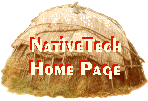|
NativeTech: Native American Technology and Art
All the plants listed here grow along the trails of Schoolhouse Brook Park in Mansfield, Connecticut. This list was compiled specifically for a trail-side tour that described the Native American uses of local plants for food and medicine, as well as some technological and ceremonial uses. Every attempt was made to credit particular Native American Tribes with the information researched. The gathering walk follows the trails, a WOODED trail on the north side of Clover Mill Road (which follows part of the traditional Nipmuc Trail) , and a POND SIDE trail on the south side of Clover Mill Road. (Gathering walk tours were provided for the Nipmuc Indian Association of CT, and for the CT State Museum of Natural History).
|
|
Click the plant names to learn how they are used for Food, Medicine & Technology
Alphabetical list of Common Names (followed by Latin Name):
AMERICAN BEECH (Fagus grandifolia) |

|
Text and Graphics
© 1994 - Tara Prindle unless otherwise cited. |
